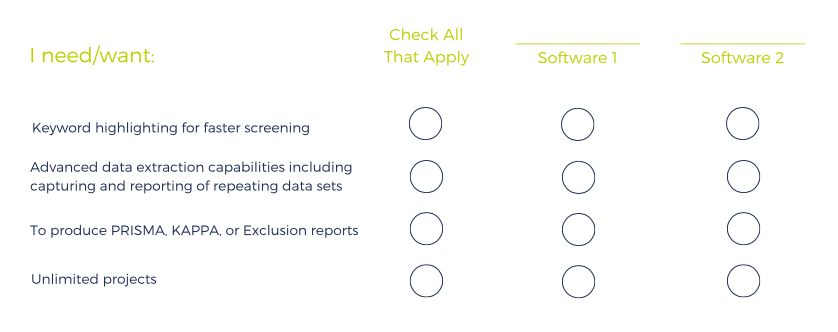So, you’re looking for a systematic review or literature review software and have no idea where to start. Well, you’ve come to the right place.
As a cursory Google search will reveal, there are options for you to choose from. But the trick, as with any purchase or investment, is to find the one that is going to fit best with your needs. Because the results of your systematic literature review could influence decision makers and (in some cases) affect lives, it is extremely important that the software you choose to help facilitate the review’s completion is appropriate and meets the needs of your project.
In order to help you make an informed decision, we have highlighted three recommendations for you to use while proceeding with your search and decision.
1. Know your needs. And your wants.
Before even beginning to look at the different options available, you should have a decent idea about what you need to do. Know what kind of capabilities you need to have from this software and what exactly you want to use it for. For example, are you planning on just using the software for screening, or do you want it to have data extraction capabilities as well? You can’t easily assess the software without knowing what requirements you need it to meet.
If you have already decided on your review protocol, even better! Make sure you consider every aspect of your protocol. For example, if you need to capture reasons for exclusion, does the software allow you to do so?
2. Make a Checklist
Once you have a clear idea of what you need and want the software to do for you, transform it into a checklist. Complete the checklist for each software you are considering.

Checking off the features that the software supports will give you a good idea which one will work for your project, and help you narrow down your decision.
3. Ask Questions
When you narrow it down to the best couple of options, be sure to talk to representatives from the organization that provides the software, or better yet, get a live demo, and ask any questions that are on your checklist that weren’t obviously addressed in the software information. In many cases, feature lists do not provide enough details to properly assess a product’s capabilities.
If your checklist can accurately be completed without asking any questions, refer back to your needs and wants that you are looking for and see if there is anything that you may have missed, or maybe want but don’t necessarily need.
Feel free to ask questions using phrases such as “for example, in my project…” and get specific answers that relate directly to your project.
These recommendations should help you to identify the best systematic review software for your project or organization.








